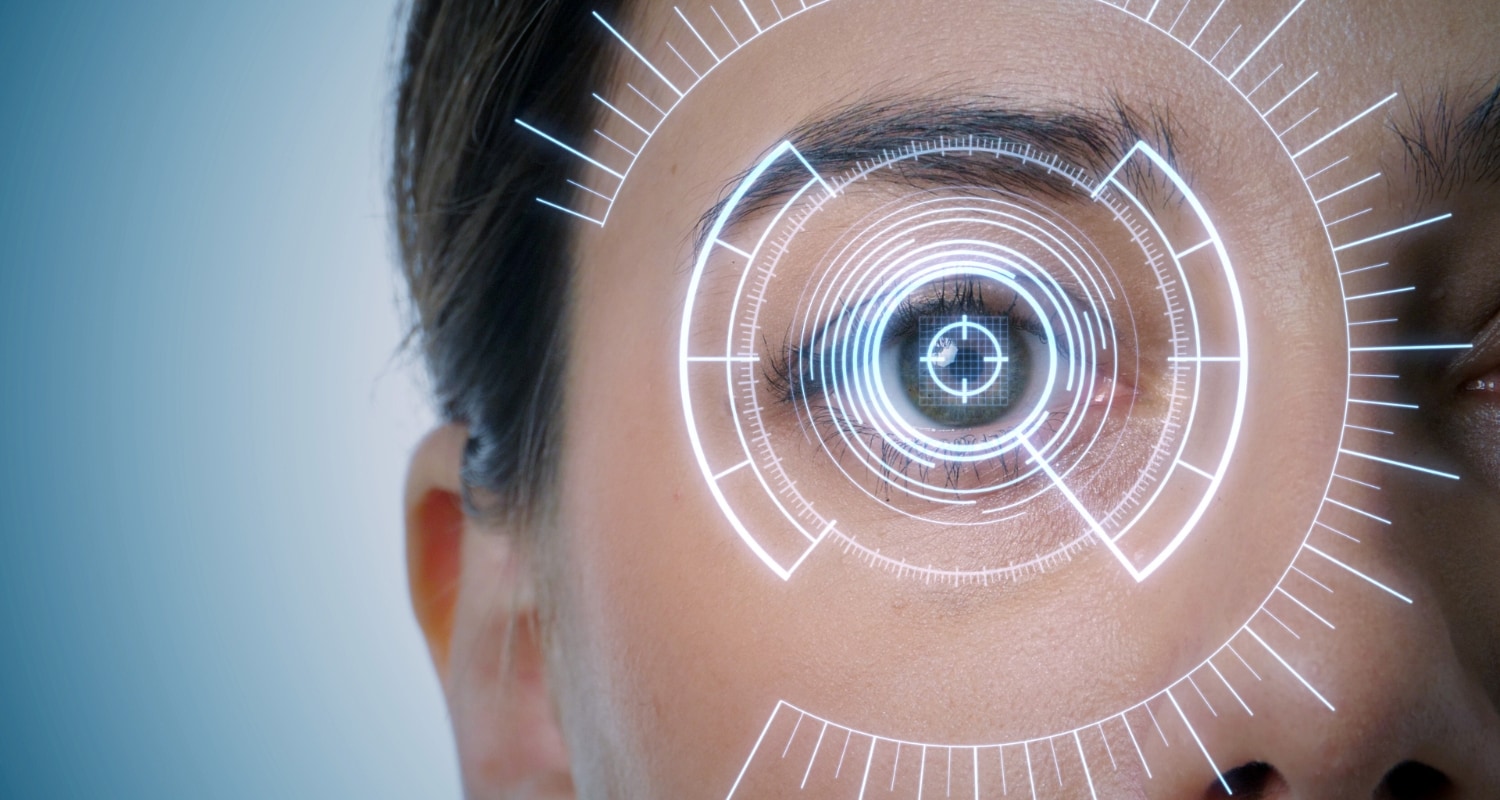The COVID-19 pandemic has undeniably brought to light the immense importance of remote patient monitoring and telehealth in our lives. In both fortunate and unfortunate circumstances, medical devices and wearables such as smartwatches and blood pressure monitors have become an integral part of our daily routines.
As the global healthcare industry increasingly embraces the utilization of remote patient monitoring technology, health systems and hospitals in the United States are already witnessing a significant surge in the adoption of RPM solutions.
The Remote Patient Monitoring (RPM) Market is projected to exceed a value of USD 125.1 Million by 2030, witnessing a remarkable growth rate of 38.6% throughout the forecast period of 2020-30, starting from an initial value of USD 23.5 Million.
In this article, we delve into the top 10 benefits of remote patient monitoring and telehealth, exploring how they enhance accessibility, improve diagnosis and treatment, support mental health, and ultimately, revolutionize the healthcare industry.
Difference of Definitions Remote Patient Monitoring And Telehealth
Let’s dive into the details of remote patient monitoring and explore its distinctions from telehealth. What sets remote patient monitoring apart and what does it entail?
Telehealth encompasses remote healthcare services utilizing health technology for distant care. Centers for Medicare & Medicaid Services (CMS) defines telehealth as the use of telecommunications and information technology for health services across distances.
A vital subset of telehealth is remote patient monitoring, using wearable devices to monitor patients outside clinical settings. These devices transmit digital health data directly to providers’ offices. With data aggregation and analysis, remote patient monitoring improves care while reducing costs.
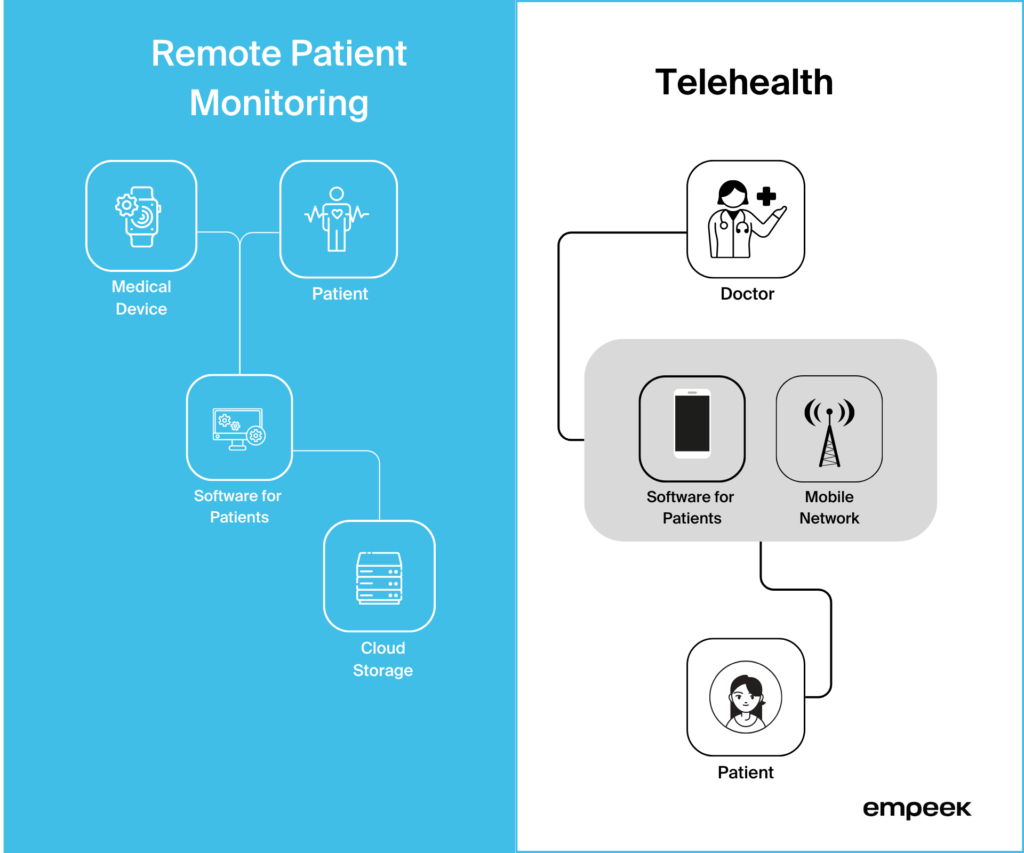
Remote patient monitoring is a coordinated system using home-based or mobile devices to transmit vital sign data or daily activity information, as per the Government Accountability Office. Medicare fee-for-service lacks a specific definition but reimburses certain monitoring services and bundles.
Benefits of Remote Patient Monitoring and Telehealth
Remote patient monitoring and telehealth technologies have ushered in a host of incredible benefits that profoundly impact patient care, healthcare outcomes, and the healthcare system as a whole.
These innovative solutions harness the potential of state-of-the-art technology to completely transform the way healthcare services are delivered and received.
Improved Patient Outcomes
RPM, in particular, has demonstrated remarkable effectiveness in reducing acute care utilization among high-risk populations. In a study conducted by the U.S. Government Accountability Office (GAO) in 2017, compelling findings emerged by leveraging RPM technologies, patients with chronic conditions like heart failure, diabetes, and hypertension can receive continuous monitoring and personalized care.
This proactive approach allows healthcare providers to promptly address any changes in patients’ health status, resulting in reduced hospitalizations, emergency department visits, and readmissions.
Telehealth, as part of the broader concept, also plays a crucial role in enhancing patient outcomes. Teleconsultations, for instance, have proven to be highly effective in reducing wait times for specialist appointments, facilitating earlier diagnoses, and improving overall care. Moreover, telehealth empowers patients to adhere to medication regimens and take charge of their own healthcare, especially for those with chronic conditions that require continuous support and monitoring.
Reduced Healthcare Costs
One of the key cost-saving benefits of RPM is its ability to monitor patients with chronic conditions in the comfort of their own homes. This shift towards home-based healthcare results in substantial savings for medical systems.
As stated by the Center for Care Transformation at AVIA, health systems can make notable strides in achieving cost savings. More specifically, when focusing on a group of 500 high-risk Medicare patients who are contending with multiple chronic conditions, the potential for substantial annual cost savings is estimated at an impressive $5.2 million.
Telehealth and RPM also optimize the allocation of staff, allowing them to focus on high-value tasks while healthcare technology handles routine monitoring and data collection. This efficient use of resources enables healthcare organizations to deliver high-quality care without incurring additional staffing costs.
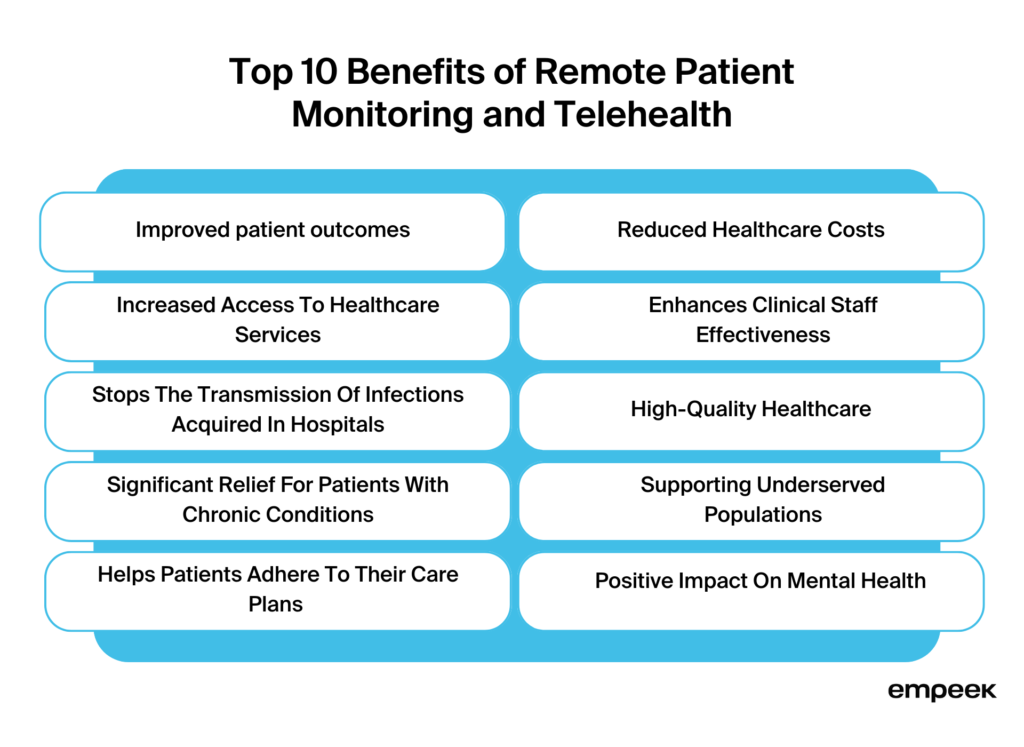
Increased Access To Healthcare Services
Accessing healthcare services can be challenging for individuals in remote areas or those with limited mobility. Remote patient monitoring and telehealth bridge this gap in this way:
- Breaking Geographical Barriers: Patients can connect with healthcare providers remotely, eliminating the need for travel.
- Addressing Provider Shortages: Providers can remotely monitor multiple patients, expanding their capacity to manage a larger population.
- Enhancing Patient Engagement and Compliance: Real-time monitoring keeps patients involved in their care plans and treatment regimens, leading to better outcomes.
- Supporting Underserved Populations: RPM benefits underserved populations, such as low-income communities or the uninsured.
Enhances Clinical Staff Effectiveness
Telehealth has the potential to alleviate the workload of healthcare practitioners and make healthcare more accessible through the integration of advanced medical-grade technology. However, for telehealth to be widely adopted, appropriate reimbursement codes are crucial.
The adoption of telehealth has provided a viable solution for the majority of physicians in the United States and Australia, allowing them to mitigate the financial setbacks caused by the pandemic. The situation differs for physicians in Germany, as only a limited number of them reported similar benefits.
This discrepancy highlights the varying degrees of telehealth integration and utilization across different healthcare systems and countries, showcasing the potential and effectiveness of telehealth in addressing financial challenges for healthcare providers during times of crisis.
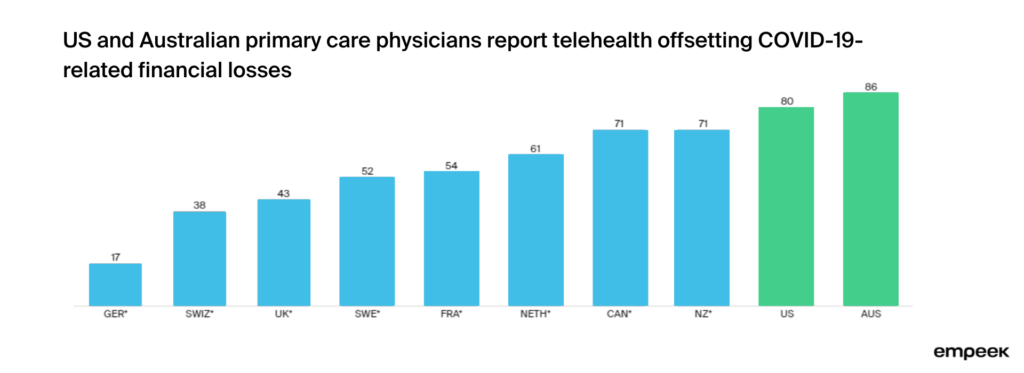
Overcoming challenges like low reimbursement rates is vital to ensure the acceptance and effectiveness of telehealth services by clinical staff.
Stops The Transmission Of Infections Acquired In Hospitals
Although a new care model was initially developed for COVID-19 units, this groundbreaking model holds great promise for extending the use of telemedicine in inpatient care.
For example, hospital-acquired infections (HAIs) are serious threats to patients, healthcare workers, and the healthcare system. These infections, such as surgical site infections, urinary tract infections, and pneumonia, result in longer hospital stays, increased morbidity and mortality, and financial burdens. Inadequate infection control, antibiotic overuse, and drug-resistant organisms contribute to HAIs.
Remote patient monitoring (RPM) and telehealth technologies offer effective solutions to reduce infection transmission in hospitals. By minimizing in-person visits and hospitalizations, these technologies enable healthcare providers to remotely assess patients’ health, detect complications early, and intervene promptly when needed.
Furthermore, telehealth services address the issue of hospital overcrowding, a major factor in spreading infections. Through remote consultations and virtual appointments, healthcare providers can prioritize critical cases, while patients with less severe conditions receive appropriate care without the risk of contracting or spreading infections within the hospital.
Helps Patients Adhere To Their Care Plans
Remote patient monitoring (RPM) and telehealth technologies have emerged as powerful tools to support and enhance patient adherence to their care plans.
For instance, the patient, with hypertension and diabetes, was struggling to manage conditions effectively. Despite receiving regular check-ups, he often forgot to take her medications on time and found it challenging to follow her prescribed diet and exercise regimen.
With the help of remote patient monitoring, the healthcare provider remotely monitored the vital signs and received real-time updates on the health status. Whenever patient blood pressure or blood glucose levels were outside the target range, the healthcare provider would receive alerts and reach out to him through virtual consultations.
Furthermore, telehealth platforms provide patients with easy access to their medical records, educational resources, and personalized care plans, ensuring that they have the necessary information and tools to adhere to their prescribed treatments and lifestyle modifications.
High-Quality Healthcare
The utilization of Remote Patient Monitoring (RPM) has demonstrated significant success across diverse healthcare environments, aiming to enhance patient care and improve overall health outcomes.
- RPM revolutionizes chronic disease management, enabling personalized care through vital data tracking. In a 2020 trial with 110 heart failure patients, RPM reduced readmissions and mortality.
- RPM empowers home monitoring, improving patient quality of life by sharing data remotely with healthcare providers, reducing readmissions.
- Integrated with telehealth, RPM enables virtual care delivery, informed decision-making, and continuous monitoring.
These instances merely scratch the surface, as ongoing advancements in RPM technology are anticipated to unlock even more innovative and practical applications, further elevating the quality of care provided to patients.
Significant Relief For Patients With Chronic Conditions
Patients who are dealing with chronic illnesses like diabetes, sleep apnea, and respiratory conditions can find tremendous advantages in utilizing remote patient monitoring (RPM) and telehealth solutions.
These advanced technologies effortlessly integrate various devices such as blood glucose meters, blood pressure monitors, and specialized equipment specifically designed for conditions like dementia and Parkinson’s disease.
Recent research has brought to light the numerous benefits of remote patient monitoring (RPM) in effectively managing complex conditions like chronic obstructive pulmonary disease (COPD) and congestive heart failure (CHF).
These studies have provided compelling evidence of the positive impact that RPM can have, including a notable decrease in emergency department visits, a reduction in hospital readmissions, and shorter hospital stays. Among physicians, a significant proportion of outpatient visits, ranging from 36.8% to 50%, were attributed to chronic conditions. Moreover, patients with chronic diseases necessitated a higher frequency of appointments, with an average of 6.8 visits per year, in contrast to 4.2 visits for patients without such conditions.
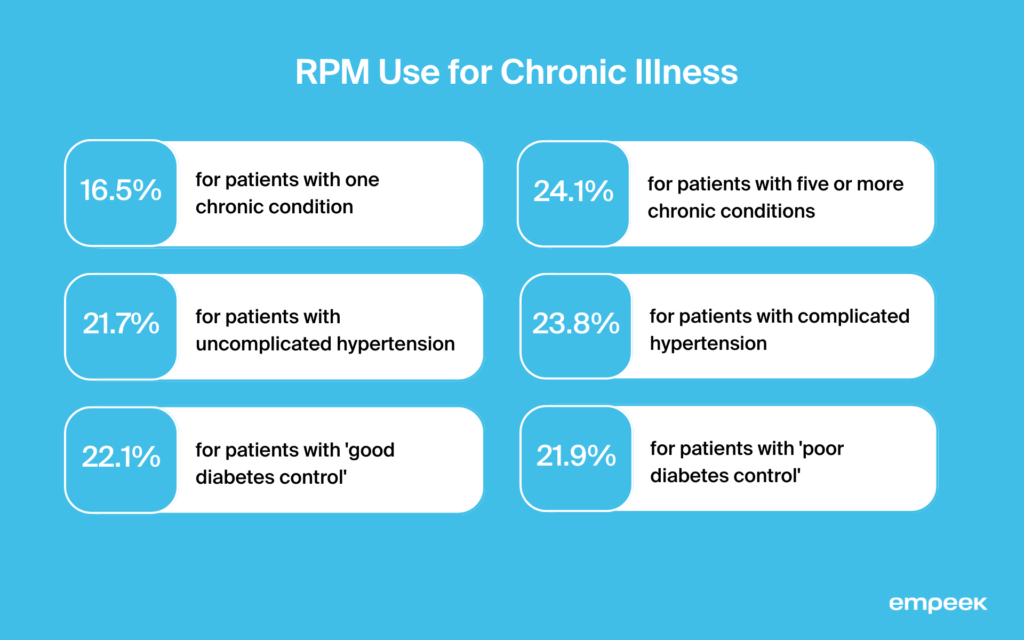
By continuously monitoring essential health data, healthcare providers acquire valuable insights into the well-being of their patients. This allows them to identify patterns, detect any unusual readings, and keep track of changes over time.
This comprehensive understanding of a patient’s health status enables healthcare professionals to personalize care plans, make informed decisions, and take timely actions.
Supporting Underserved Populations
Telehealth becomes especially significant for underserved populations, providing them with a vital resource to overcome barriers that impede effective healthcare access.
Transportation needs, distance from specialty providers, time off work, and childcare are common obstacles faced by these populations. Telehealth eliminates these barriers by bringing care directly to patients, regardless of their location.
Studies have shown the positive impact of telehealth and remote patient monitoring on underserved populations. Virtual clinical appointments have resulted in significant savings in terms of travel distance and time, providing patients with the care they need without extensive burdens. On average, patients were able to save approximately 145 miles of travel distance and 142 minutes of their time per visit.
Improvements in internet connectivity and RPM technology itself, such as data device retention, further enhance the effectiveness of telehealth and RPM in community health centers. Initiatives, like funding from the Health Resources and Services Administration (HRSA) to improve broadband access in rural areas, address the previous limitations related to internet connectivity.
Positive Impact On Mental Health
By leveraging RPM and telehealth, individuals can connect with mental health professionals remotely, eliminating the need for in-person appointments.
This breakthrough not only increases access to care but also overcomes obstacles like long travel distances and limited availability of mental health providers. With just a few clicks, individuals can now receive the support they need, right from the comfort of their own homes.
Recent data highlights that a significant portion, approximately 40% of adults in the United States have experienced psychological distress in response to the COVID-19 pandemic.
Looking ahead, the integration of remote patient monitoring (RPM) devices offers a promising avenue for identifying and addressing mental health conditions by analyzing key physical indicators such as activity levels, sleep patterns, and heart rate.
Furthermore, the integration of artificial intelligence (AI) and machine learning algorithms, combined with the utilization of wearables, enables personalized and real-time monitoring of mental health indicators.
These advanced technologies empower healthcare providers to detect early warning signs and intervene promptly, leading to more effective management of mental health conditions.
Conclusion
The landscape of healthcare delivery is undergoing a transformative shift with the remarkable progress of telemedicine and remote patient monitoring (RPM) technologies. These advancements hold great promise, particularly for individuals in rural areas, those facing mobility challenges, and patients with chronic conditions.
Looking ahead, we can anticipate further progress and collaboration among healthcare providers, technology firms, and policymakers to ensure the effective utilization of telemedicine and RPM. As we embrace these healthcare innovations, it is imperative to address concerns and limitations while seamlessly integrating them into existing healthcare systems.
At Empeek, we are committed to delivering state-of-the-art solutions in these domains, as evident from our proven expertise and successful client partnerships. We invite you to explore how our team can assist you in implementing tailored remote patient monitoring and telehealth solutions in improving care.

